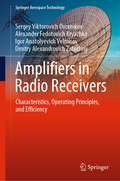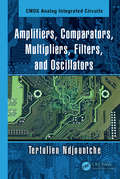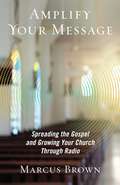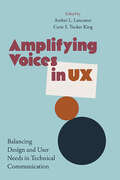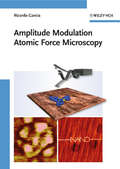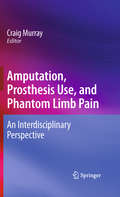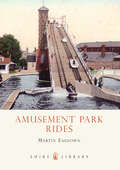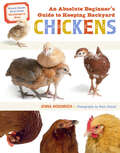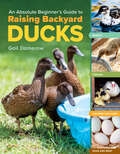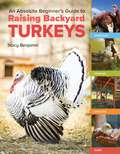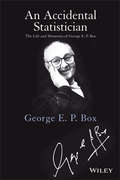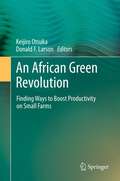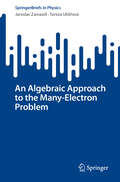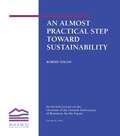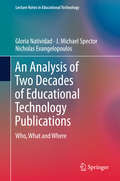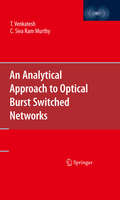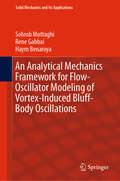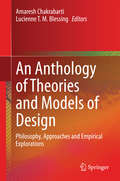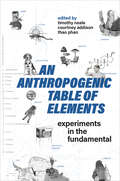- Table View
- List View
Amphibious Warfare: Battle on the Beaches (Casemate Short History)
by Oscar E. Gilbert Romain Cansiere&“An easily accessible short history&” of offensive military operations on hostile shores from the authors of First to Fight: The U.S. Marines in World War I (Midwest Book Review). One of the most difficult types of warfare to master, landing on a hostile beach requires scrupulous planning and intense coordination between the air, sea, and land forces. With a history reaching back to the Persians landing on the Greek shores at the Battle of Marathon in 490 BC, it was the First World War that marked the beginning of modern amphibious warfare, with the Royal Marines combining their efforts with the Royal Navy. Despite the disastrous Gallipoli amphibious operation to seize the Dardanelles Straits in 1915, the Royal Navy and US Marine Corps continued to develop new landing crafts through the interwar years. The Second World War proved more successful for amphibious warfare, with the Japanese invasion of the Philippines in 1941 crushing the American forces defending the Pacific islands and the D-Day landings by the Allied troops in 1944 initiating the beginning of the end of the war in Europe. This accessible short history looks at the historical development of amphibious warfare, telling the stories of particular landings and the units that have taken part in this unique type of warfare. The Royal Marines and US Marine Corps continue to evolve and play a crucial role in defense today, with specialized amphibious warfare ships being deployed to enable elite forces to respond promptly to threats across the globe. &“A brief but very useful overview of an important aspect of modern warfare.&” —Baird Maritime
Amplifiers in Radio Receivers: Characteristics, Operating Principles, and Efficiency (Springer Aerospace Technology)
by Dmitry Alexandrovich Zatuchny Sergey Viktorovich Dvornikov Alexander Fedotovich Kryachko Igor Anatolyevich VelmisovThis book presents the basics of building various types of amplifiers, the most widely used in the composition of modern specialized radio receivers, as well as the principles of building digital radio receivers. The rapid development of modern telecommunications systems, aviation equipment, and space systems for various functional purposes, as well as new information technologies, is inextricably linked with the theory of building radio receivers. Radio receivers are an integral part of the radio line, which largely determine the quality of its operation, both in normal operating conditions and in a complex interference environment. Since the creation of the first lightning detector in 1895, the technique of radio receiving devices went a long way to the development of modern automated digital systems.
Amplifiers, Comparators, Multipliers, Filters, and Oscillators
by Tertulien NdjountcheThe book presents design methods for analog integrated circuits with improved electrical performance. It describes different equivalent transistor models, design methods, and fabrication considerations for high-density integrated circuits in nanometer CMOS processes, and it analyzes circuit architectures that are suitable for analog building blocks. Highlighting various design challenges, the text offers a complete understanding of architectural- and transistor-level design issues of analog integrated circuits. It examines important trends in the design of high-speed and power-efficient front-end analog circuits that can be used for signal conditioning, filtering, and detection applications. Offers a comprehensive resource for mastering the analysis of analog integrated circuits. Describes circuit-level details of high-speed and power-efficient analog building blocks. Explores design methods based on various MOS transistor models (MOSFET, FinFET). Provides mathematical derivations of all equations and formulas. Emphasizes practical aspects relevant to integrated circuit implementation. Includes open-ended circuit design case studies.
Amplify Your Message: Spreading the Gospel and Growing Your Church Through Radio
by Marcus BrownAnd (Jesus) said to them, 'Go into all the world and proclaim the Gospel to the whole creation.' Mark 16:15 (ESV) The need for proclaiming the Good News to the world has never been greater. Recent statistics reveal that 63% of Americans go to church less than once a month, and almost half of that group never set foot inside a church. That puts us in a dilemma. If those in need of the message of salvation through Jesus Christ aren’t coming to our churches, how do we reach them? How then will they call on him in whom they have not believed? And how are they to believe in him of whom they have never heard? And how are they to hear without someone preaching? And how are they to preach unless they are sent? Romans 10:14-15 (ESV) Salem Media Group has an answer: Radio. Nielsen Media Research—the world’s leader in media data—has found “traditional AM/FM terrestrial radio still retains its undiminished appeal for listeners; 91% of Americans, aged 12 and older, listen to this form of radio.” When radio is amplified with new technology, its reach is powerful. When matched with biblical preaching and teaching, God’s Kingdom expands. Not only are the lost led to salvation, they are drawn to your church, putting them where they need to be to become disciples. This book details how a local Salem Media radio platform can partner with your church to fulfill the Great Commission and grow your ministry. From the “why” to the “how,” we give you everything you need to prayerfully consider this opportunity to pierce the darkness in your community with the Light of the World.
Amplify-and-Forward Relaying in Wireless Communications (SpringerBriefs in Computer Science)
by Tho Le-Ngoc Leonardo Jiménez Rodríguez Nghi TranThis SpringerBrief explores the advantage of relaying techniques in addressing the increasing demand for high data rates and reliable services over the air. It demonstrates how to design cost-effective relay systems that provide high spectral efficiency and fully exploit the diversity of the relay channel. The brief covers advances in achievable rates, power allocation schemes, and error performance for half-duplex (HD) and full-duplex (FD) amplify-and-forward (AF) single-relay systems. The authors discuss the capacity and respective optimal power allocation for a wide range of HD protocols over static and fading channels. Then, optimal amplification coefficients in terms of achievable rate are presented. Chapters also examine performance with finite constellations, including the error and diversity performance. The brief concludes with a capacity and error performance analysis of the FD relay mode of operation, where the residual self-interference due to FD transmission is explicitly taken into account. Amplify-and-Forward Relaying in Wireless Communications reveals the benefits and challenges of relaying techniques. It is designed for researchers and professionals in wireless communication. This material is also appropriate for advanced-level students in electrical engineering and computer science.
Amplifying Informal Science Learning: Rethinking Research, Design, and Engagement
by Judy Diamond Sherman RosenfeldThis collection explores the broad landscape of current and future out-of-school science learning environments. Written by leading experts and innovators in informal science learning, these thoughtful and critical essays examine the changing nature of informal institutions such as science museums, zoos, nature centers, planetariums, aquaria, and botanical gardens and their impact on science education. The book examines the learning opportunities and challenges created by community-based experiences including citizen science, makerspaces, science media, escape rooms, hobby groups, and gaming. Based on current practices, case studies, and research, the book focuses on four cross-cutting themes – inclusivity, digital engagement, community partnerships, and bridging formal and informal learning – to examine how people learn science informally. The book will be of interest to STEM (science, technology, engineering and math) educators – both in and out of school – designers of science and experiential education programs, and those interested in building STEM learning ecosystems in their communities.
Amplifying Voices in UX: Balancing Design and User Needs in Technical Communication (SUNY series, Studies in Technical Communication)
by Amber L. Lancaster; Carie S. Tucker KingThe field of technical and professional communication is young, and research related to it—and specifically usability—is constantly growing. Usability and user-experience researchers are broadening research into studies involving social issues, accessibility, reconciliation, and user advocacy. Amplifying Voices in UX explores the theme of balance in design and UX in three main areas: curriculum design that includes empathy, service learning, and design justice; design and balance for effective medical and health communication; and design to create balance in labor, social, civic, and political movements.
Amplitude Modulation Atomic Force Microscopy
by Ricardo GarcíaFilling a gap in the literature, this book features in-depth discussions on amplitude modulation AFM, providing an overview of the theory, instrumental considerations and applications of the technique in both academia and industry. As such, it includes examples from material science, soft condensed matter, molecular biology, and biophysics, among others. The text is written in such a way as to enable readers from different backgrounds and levels of expertise to find the information suitable for their needs.
Amputation, Prosthesis Use, and Phantom Limb Pain: An Interdisciplinary Perspective
by Craig MurrayThe book will contain contributions from the fields of anthropology, biomedical engineering, computer science, neuroscience, nursing, prosthetics and orthotics, psychology, and rehabilitative medicine. It will be comprised of three broad interrelated sections. Following an introductory chapter in which the topics and chapters of the book are overviewed, the first section ("Providing and Monitoring the Use of Prostheses") will concentrate on the work of prostheticians and will consist of three chapters. The first of these, written by a clinician responsible for the provision of prosthetics in a large regional area of the UK, will present a range of ethical and medico-legal issues for rehabilitation professionals in the supply and withdrawal of prostheses and assistive technology for people with limb loss or deformity. The second chapter, provided by a prosthetician and prosthetic engineers, will present the development of an innovative computerized technique for monitoring upper limb prosthesis activity. The final chapter in this section is written by an anthropologist, himself an amputee, presenting ethnographic work on how prostheticians and their clients actually "go about" providing artificial limbs. Together these chapters explicate the processes involved in prostheticians' work with clients in a manner which will be of interest to students and professionals from a range of disciplines. Section 2 ("The Experience and Meaning of Prosthesis Use") focuses on the experiences and meanings of prosthesis users themselves. The first of three chapters, written by members of the Dublin Psychoprothetics Group, explores the ways in which people adapt and cope with limb loss and using a prosthesis, the potential for positive adjustment and strengths emerging from the experience, pain, affective distress, issues around identity, body image, and the construction of self and quality of life. It also considers the importance of these issues for health service providers across the multidisciplinary team who work with people with limb loss. The second chapter provides a reflective critique of the themes in the book, namely, the process of prosthetic rehabilitation, by way of a reprint of Gelya Frank's classic paper "Beyond Stigma: Visibility and Self-Empowerment of Persons with Congenital Limb Deficiencies," along with a new commentary from the author herself. This chapter focuses on the experiences of people born with congenital limb deficiencies who have chosen not to use prosthetics as part of a strategy to counteract the stigmatization of disability and bodily difference. The views of these participants provide challenges to a range of professionals involved in the rehabilitation of people with amputations and limb deficiencies. The final chapter of this section presents a range of themes in the experiences of people who choose to use prosthetics following amputation or limb absence, including the embodied used of prosthesis and the integration of these into the identity of the persons concerned. The final section (postoperative pain and new treatments of phantom limb pain) focuses on phantom limb pain and emerging therapies for this phenomenon. The first of four chapters presents a clinician's account of post amputation pain, stressing how this is temporally dependent, varying at different stages of the perioperative/postoperative period, with possibly more than one pain being present at any time. In considering the complex amalgam of pain contributors the author argues for a full biopsychosocial assessment to be made with attention and treatment given to any associated mood disorder, disorder of cognition or behavioral maladaptations. These considerations are developed further in the following chapter where, written from a nursing perspective, the coping style of patients in relation to phantom limb pain are discussed and compared with other pain conditions. The final two chapters in this section present two emerging therapies for phantom limb pain which have received particular academic and media attention. This condition ...
Amusement Park Rides
by Martin EasdownA ride on a thrill rollercoaster is the highlight of any visit to an amusement or theme park. Today's rides are at the cutting edge of technology and engineering, but they are but the latest of a long line of rides with humble roots in Russian ice slides and wooden sleigh rides. Seaside historian Martin Easdown describes the great age of these fascinating structures, from the first mass produced rollercoaster, the Switchback Railway, through to the giant wooden coasters of the inter-war period, using historic postcards and photographs to chart their development. The fullest expression of the popularity of rollercoasters was to be found at the great British seaside and popular amusement parks, such as Blackpool Pleasure Beach, Southend Kursaal and Margate Dreamland, which were created around the rides. The author also goes beyond rollercoasters to other amusement rides, such as revolving towers, aerial rides, Ferris wheels and water chutes that were produced from the late Victorian era in all manner of fascinating forms. This book is a celebration of how rollercoaster and other amusements enthralled and thrilled and became a much-loved feature of our leisure industry.
An ASIC Low Power Primer: Analysis, Techniques and Specification
by J. Bhasker Rakesh ChadhaThis book provides an invaluable primer on the techniques utilized in the design of low power digital semiconductor devices. Readers will benefit from the hands-on approach which starts form the ground-up, explaining with basic examples what power is, how it is measured and how it impacts on the design process of application-specific integrated circuits (ASICs). The authors use both the Unified Power Format (UPF) and Common Power Format (CPF) to describe in detail the power intent for an ASIC and then guide readers through a variety of architectural and implementation techniques that will help meet the power intent. From analyzing system power consumption, to techniques that can be employed in a low power design, to a detailed description of two alternate standards for capturing the power directives at various phases of the design, this book is filled with information that will give ASIC designers a competitive edge in low-power design.
An Absolute Beginner's Guide to Keeping Backyard Chickens: Watch Chicks Grow from Hatchlings to Hens
by Jenna WoginrichWith delightful photographs, Jenna Woginrich chronicles the life journey of three chickens (Amelia, Honey, and Tilda) from fluffy, newly hatched bundles to grown hens laying eggs of their own. Following their progress from day to day and week to week, you'll learn everything you need to know to be successful in raising and keeping a happy, healthy flock. Topics covered include understanding chicken behavior; housing and feeding requirements; and hygiene and basic health care. Both entertaining and educational, this highly accessible book provides just the right amount of information to get started and enjoy the pleasures of keeping backyard chickens. This publication conforms to the EPUB Accessibility specification at WCAG 2.0 Level AA.
An Absolute Beginner's Guide to Raising Backyard Ducks: Breeds, Feeding, Housing and Care, Eggs and Meat
by Gail DamerowThis inspiring introductory guide provides all the information beginners need to raise ducks successfully in the yard or on a small homestead or farm. Ducks are quickly gaining on chickens as popular animals for the backyard homestead or small farm. They are friendly, productive, good at eating pests, remarkably healthy, and easier to raise than chickens in many ways. Plus, they are exceptionally adorable! This accessible introductory guide features original photography tracking the growth and care of a small flock of backyard ducks, and addresses everything the beginner duck keeper needs to know to be successful, including breed selection, housing, feeding, health care, understanding behavior, and egg and meat production. This publication conforms to the EPUB Accessibility specification at WCAG 2.0 Level AA.
An Absolute Beginner's Guide to Raising Backyard Turkeys: Varieties, Feeding, Shelter, Care
by Stacy BenjaminFrom an expert in homesteading, this accessible guide shows you how to nurture happy, healthy turkeys right in your own yard. Written by a backyard homesteader with a small flock of heritage turkeys, An Absolute Beginner's Guide to Raising Backyard Turkeys focuses on eggs, meat, and personal enjoyment. Poultry expert Stacy Benjamin will show you how to: -Raise your own poults -Understand turkey behavior and breeding habits -Provide proper shelter and nutrition Includes full-color photographs.
An Accidental Statistician
by George E. BoxCelebrating the life of an admired pioneer in statisticsIn this captivating and inspiring memoir, world-renowned statistician George E. P. Box offers a firsthand account of his life and statistical work. Writing in an engaging, charming style, Dr. Box reveals the unlikely events that led him to a career in statistics, beginning with his job as a chemist conducting experiments for the British army during World War II. At this turning point in his life and career, Dr. Box taught himself the statistical methods necessary to analyze his own findings when there were no statisticians available to check his work.Throughout his autobiography, Dr. Box expertly weaves a personal and professional narrative to illustrate the effects his work had on his life and vice-versa. Interwoven between his research with time series analysis, experimental design, and the quality movement, Dr. Box recounts coming to the United States, his family life, and stories of the people who mean the most to him.This fascinating account balances the influence of both personal and professional relationships to demonstrate the extraordinary life of one of the greatest and most influential statisticians of our time. An Accidental Statistician also features:* Two forewords written by Dr. Box's former colleagues and closest confidants* Personal insights from more than a dozen statisticians on how Dr. Box has influenced and continues to touch their careers and lives* Numerous, previously unpublished photos from the author's personal collectionAn Accidental Statistician is a compelling read for statisticians in education or industry, mathematicians, engineers, and anyone interested in the life story of an influential intellectual who altered the world of modern statistics.
An African Green Revolution: Finding Ways to Boost Productivity on Small Farms (Natural Resource Management and Policy #48)
by Keijiro Otsuka Donald F. LarsonThis volume explores the usefulness of the Asian model of agricultural development for Africa, where, even before the recent world food crisis, half the population lived on less than on dollar a day, and a staggering one in three people and one third of all children were undernourished. Africa has abundant natural resources; agriculture provides most of its jobs, a third of national income and a larger portion of total export earnings. However the levels of land and labor productivity rank among the worst in the world. The book explains Africa's productivity gap and proposes ways to close it, by examining recent experience in Africa and by drawing on lessons from Asia.
An Algebraic Approach to the Many-Electron Problem (SpringerBriefs in Physics)
by Jaroslav Zamastil Tereza UhlířováThis book presents an algebraic approach to the coupled cluster method for many-electron systems, pioneered by Josef Paldus. Using field methods along with an algebraic, rather than diagrammatic, approach facilitates a way of deriving the coupled cluster method which is readily understandable at the graduate level. The book begins with the notion of the quantized electron field and shows how the N-electron Hamiltonian can be expressed in its language. This is followed by introduction of the Fermi vacuum and derivation of the Hartree-Fock equations along with conditions for stability of their solutions. Following this groundwork, the book discusses a method of configuration interaction to account for dynamical correlations between electrons, pointing out the size-extensivity problem, and showing how this problem is solved with the coupled cluster approach. This is followed by derivation of the coupled cluster equations in spin-orbital form. Finally, the book explores practical aspects, showing how one may take advantage of permutational and spin symmetries, and how to solve coupled-cluster equations, illustrated by the Hubbard model of benzene, the simplest quasi-realistic model of electron correlation.
An Almost Practical Step Toward Sustainability: An Invited Lecture On The Occasion Of The Fortieth Anniversary Of Resources For The Future
by Robert M. SolowNobel Laureate Robert Solow explores how changes in social accounting practice could contribute to more rational debate and action in crafting economic and environmental policy. A thoughtful work about the wise use of society's natural resources, intergenerational equity, and the translation of ideas about sustainability into real policy.
An American Hero: An Authorized Biography
by Philip SingermanAn American Hero: The RedAdair Story. Back in the days of the great Texas oil fields when fortunes were made and lost overnight, they said derricks were built out of wood but the men were carved from steel. Red Adair is such a man. A genuine American hero, this daredevil firefighter has been combating the most terrifying force of nature all over the world for more than fifty years. Red has braved gas and oil-well fires that send walls of flame hundreds of feet in the air, fires so hot they melt nearby trucks fires that can roast a man. From the wild and free-spirited days in the Texas oil patches to scenes of front line fire battles in Malaya and Algeria, Red tells how and why he repeatedly risked his own life challenging some of the worst disasters of modern times. -
An American Railroad Dream: My Career As A Locomotive Engineer
by Susie Gaglia Patrick MorrisonSusie Gaglia reminisces about fulfilling her childhood dream with her career as railroad engineer for passenger and freight trains along the Northeast Corridor during the mid twentieth century. Beginning with her upbringing in a suburb of Buffalo through the process of qualifying to operate locomotives to vignettes from her fifteen-year career, Susie remembers kind mentors, close encounters on the tracks, near misses, massive accidents, and moments of sexual harassment as she fulfilled an American railroad dream.
An Analysis of Two Decades of Educational Technology Publications: Who, What And Where (Lecture Notes In Educational Technology)
by J. Michael Spector Nicholas Evangelopoulos Gloria NatividadProvides a comprehensive and up-to-date review of educational technology research articles.<P><P> Presents a clustered analysis showing the trends over the last 20 years.<P> Discusses the leading authors and journals in the subject area.<P> This book presents a challenging and multi-faceted research project that required state-of-the-art methodological approaches. The project involved analyzing data collected from 10,000 research articles published in ten leading journals in the area of educational technology over 20 years, from January 1994 to December 2014; advanced analytic approaches such as latent semantic analysis; and expert insights and interpretations of the subject matter.<P> It captures the trends in a number of research streams within the discipline of educational technology and identifies the point in time when a massive change took place. This is a significant achievement given that, in epistemology and philosophy of science, there have always been discussions of paradigm shifts, but researchers have always identified them qualitatively. This is the first work to identify a paradigm shift using rigorous quantitative methods. <P> The analysis procedure involved big data and sophisticated analysis, which supported the identification of clusters at several breakpoints from which the richest set was selected in order to provide the most detailed analysis. This comprehensive analysis also shows what has been published and by whom in those ten top-tier journals. This work makes a highly significant contribution to the field of learning technologies and provides the groundwork and a significant data source for other scholars, both new and experienced, to build on and expand in their work.
An Analytical Approach to Optical Burst Switched Networks
by C. Siva Murthy T. VenkateshThis book presents the state of the art results on modeling and analysis of OBS networks. It provides researchers with new directions for future research and helps them gain a better understanding of modeling OBS networks. This book classifies all the literature on modeling and analysis of OBS networks and serves as a thought provoking material for the researchers working on the analysis of high-speed networks. The scope of this book however is not limited to OBS networks alone but extends to high-speed communication networks with limited or no buffers.
An Analytical Mechanics Framework for Flow-Oscillator Modeling of Vortex-Induced Bluff-Body Oscillations (Solid Mechanics and Its Applications #260)
by Haym Benaroya Sohrob Mottaghi Rene GabbaiThis self-contained book provides an introduction to the flow-oscillator modeling of vortex-induced bluff-body oscillations. One of the great challenges in engineering science also happens to be one of engineering design – the modeling, analysis and design of vibrating structures driven by fluid motion. The literature on fluid–structure interaction is vast, and it can be said to comprise a large fraction of all papers published in the mechanical sciences. This book focuses on the vortex-induced oscillations of an immersed body, since, although the importance of the subject has long been known, it is only during the past fifty years that there have been concerted efforts to analytically model the general behavior of the coupling between vortex shedding and structural oscillations. At the same time, experimentalists have been gathering data on such interactions in order to help define the various regimes of behavior. This data is critical to our understanding and to those who develop analytical models, as can be seen in this book. The fundamental bases for the modeling developed in this book are the variational principles of analytical dynamics, in particular Hamilton’s principle and Jourdain’s principle, considered great intellectual achievements on par with Newton’s laws of motion. Variational principles have been applied in numerous disciplines, including dynamics, optics and quantum mechanics. Here, we apply variational principles to the development of a framework for the modeling of flow-oscillator models of vortex-induced oscillations.
An Anthology of Theories and Models of Design: Philosophy, Approaches and Empirical Explorations
by Amaresh Chakrabarti Lucienne T. M. BlessingWhile investigations into both theories and models has remained a major strand of engineering design research, current literature sorely lacks a reference book that provides a comprehensive and up-to-date anthology of theories and models, and their philosophical and empirical underpinnings; An Anthology of Theories and Models of Design fills this gap. The text collects the expert views of an international authorship, covering: #65533; significant theories in engineering design, including CK theory, domain theory, and the theory of technical systems; #65533; current models of design, from a function behavior structure model to an integrated model; #65533; important empirical research findings from studies into design; and #65533; philosophical underpinnings of design itself. For educators and researchers in engineering design, An Anthology of Theories and Models of Design gives access to in-depth coverage of theoretical and empirical developments in this area; for practitioners, the book will provide exposure to theoretical and empirical foundations to methods and tools that are currently practiced as well as those in the process of development.
An Anthropogenic Table of Elements: Experiments in the Fundamental (Technoscience and Society)
by Timothy Neale Courtney Addison Thao PhanAn Anthropogenic Table of Elements provides a contemporary rethinking of Dmitri Mendeleev’s periodic table of elements, bringing together "elemental" stories to reflect on everyday life in the Anthropocene. Concise and engaging, this book provides stories of scale, toxicity, and temporality that extrapolate on ideas surrounding ethics, politics, and materiality that are fundamental to this contemporary moment. Examining elemental objects and forces, including carbon, mould, cheese, ice, and viruses, the contributors question what elemental forms are still waiting to emerge and what political possibilities of justice and environmental reparation they might usher into the world. Bringing together anthropologists, historians, and media studies scholars, this book tests a range of possible ways to tabulate and narrate the elemental as a way to bring into view fresh discussion on material constitutions and, thereby, new ethical stances, responsibilities, and power relations. In doing so, An Anthropogenic Table of Elements demonstrates through elementality that even the smallest and humblest stories are capable of powerful effects and vast journeys across time and space.

